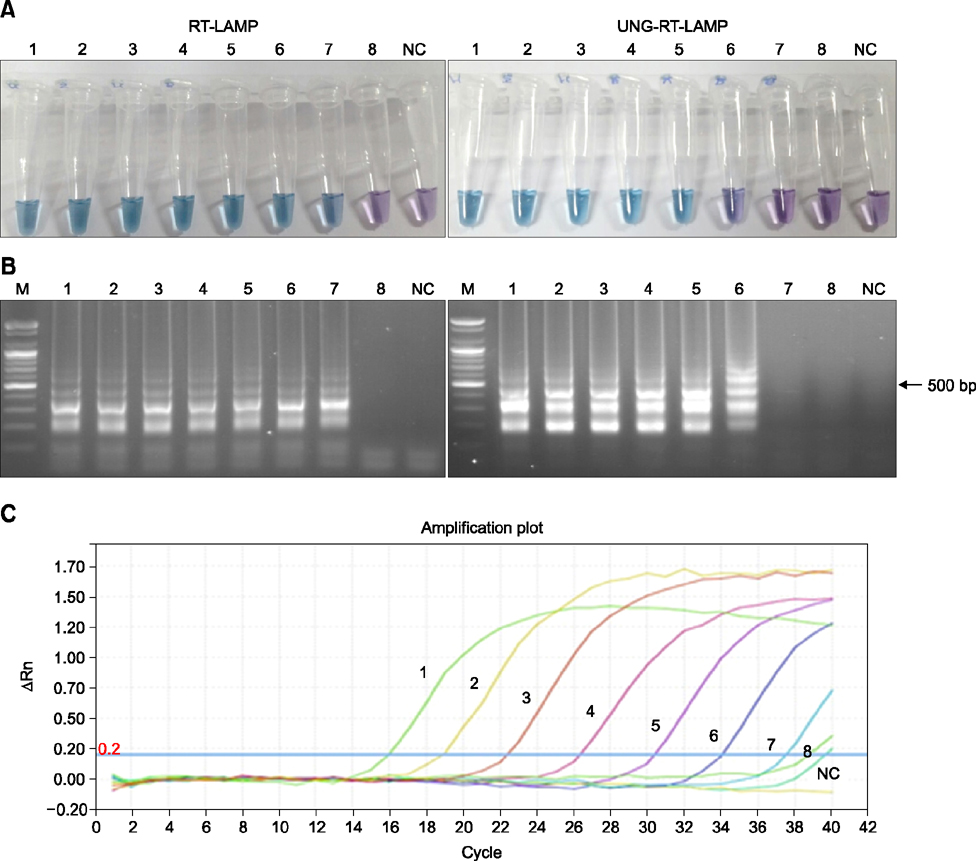J Vet Sci.
2016 Sep;17(3):421-425. 10.4142/jvs.2016.17.3.421.
Uracil-DNA glycosylase-treated reverse transcription loop-mediated isothermal amplification for rapid detection of avian influenza virus preventing carry-over contamination
- Affiliations
-
- 1College of Veterinary Medicine & Animal Disease Intervention Center, Kyungpook National University, Daegu 41566, Korea. parkck@knu.ac.kr
- 2RAD Inc., Daegu 39852, Korea.
- 3M Monitor Inc., Daegu 41914, Korea.
- 4Virology Division, Animal and Plant Quarantine Agency, Gimcheon 39660, Korea.
- 5Avian Disease Division, Animal and Plant Quarantine Agency, Gimcheon 39660, Korea.
- KMID: 2413144
- DOI: http://doi.org/10.4142/jvs.2016.17.3.421
Abstract
- Here, we describe a uracil-DNA glycosylase (UNG)-treated reverse transcription loop-mediated isothermal amplification (uRT-LAMP) for the visual detection of all subtypes of avian influenza A virus (AIV). The uRT-LAMP assay can prevent unwanted amplification by carryover contamination of the previously amplified DNA, although the detection limit of the uRT-LAMP assay is 10-fold lower than that of the RT-LAMP without a UNG treatment. To the best of our knowledge, this is the first successful application of deoxyuridine triphosphate/UNG strategy in RT-LAMP for AIV detection, and the assay can be applied for the rapid, and reliable diagnosis of AIVs, even in contaminated samples.
Keyword
MeSH Terms
Figure
Reference
-
1. Bao Y, Bolotov P, Dernovoy D, Kiryutin B, Zaslavsky L, Tatusova T, Ostell J, Lipman D. The influenza virus resource at the National Center for Biotechnology Information. J Virol. 2008; 82:596–601.
Article2. Dhama K, Karthik K, Chakraborty S, Tiwari R, Kapoor S, Kumar A, Thomas P. Loop-mediated isothermal amplification of DNA (LAMP): a new diagnostic tool lights the world of diagnosis of animal and human pathogens: a review. Pak J Biol Sci. 2014; 17:151–166.
Article3. Hsieh K, Mage PL, Csordas AT, Eisenstein M, Soh HT. Simultaneous elimination of carryover contamination and detection of DNA with uracil-DNA-glycosylase-supplemented loop-mediated isothermal amplification (UDG-LAMP). Chem Commun (Camb). 2014; 50:3747–3749.
Article4. Kil EJ, Kim S, Lee YJ, Kang EH, Lee M, Cho SH, Kim MK, Lee KY, Heo NY, Choi HS, Kwon ST, Lee S. Advanced loop-mediated isothermal amplification method for sensitive and specific detection of Tomato chlorosis virus using a uracil DNA glycosylase to control carry-over contamination. J Virol Methods. 2015; 213:68–74.
Article5. Kim EM, Jeon HS, Kim JJ, Kim HJ, Shin YK, Song JY, Yeo SG, Park CK. Loop-mediated isothermal amplification assay for the rapid detection of swine influenza virus. Korean J Vet Serv. 2015; 38:107–116.
Article6. Kim HR, Oem JK, Bae YC, Kang MS, Lee HS, Kwon YK. Application of real-time reverse transcription polymerase chain reaction to the detection the matrix, H5 and H7 genes of avian influenza viruses in field samples from South Korea. Virol J. 2013; 10:85.
Article7. Longo MC, Berninger MS, Hartley JL. Use of uracil DNA glycosylase to control carry-over contamination in polymerase chain reactions. Gene. 1990; 93:125–128.
Article8. Mori Y, Notomi T. Loop-mediated isothermal amplification (LAMP): a rapid, accurate, and cost-effective diagnostic method for infectious diseases. J Infect Chemother. 2009; 15:62–69.
Article9. Notomi T, Okayama H, Masubuchi H, Yonekawa T, Watanabe K, Amino N, Hase T. Loop-mediated isothermal amplification of DNA. Nucleic Acids Res. 2000; 28:E63.
Article10. Shivakoti S, Ito H, Murase T, Ono E, Takakuwa H, Yamashiro T, Otsuki K, Ito T. Development of reverse transcription-loop-mediated isothermal amplification (RT-LAMP) assay for detection of avian influenza viruses in field specimens. J Vet Med Sci. 2010; 72:519–523.
Article11. Wang HC, Kasper G. Filtration efficiency of nanometer-size aerosol particles. J Aerosol Sci. 1991; 22:31–41.
Article12. World Health Organization. WHO information for molecular diagnosis of influenza virus - update. Geneva: World Health Organization;2014.13. Yoshida H, Sakoda Y, Endo M, Motoshima M, Yoshino F, Yamamoto N, Okamatsu M, Soejima T, Senba S, Kanda H, Kida H. Evaluation of the reverse transcription loop-mediated isothermal amplification (RT-LAMP) as a screening method for the detection of influenza viruses in the fecal materials of water birds. J Vet Med Sci. 2011; 73:753–758.
Article14. Zhang X, Lowe SB, Gooding JJ. Brief review of monitoring methods for loop-mediated isothermal amplification (LAMP). Biosens Bioelectron. 2014; 61:491–499.
Article
- Full Text Links
- Actions
-
Cited
- CITED
-
- Close
- Share
- Similar articles
-
- Development of reverse transcription loop-mediated isothermal amplification assays for point-of-care testing of avian influenza virus subtype H5 and H9
- Development of reverse-transcription loop-mediated isothermal amplification assays for point-of-care testing of human influenza virus subtypes H1N1 and H3N2
- A reverse transcription loop-mediated isothermal amplification assay to rapidly diagnose foot-and-mouth disease virus C
- Rapid detection of Mycobacterium leprae for the diagnosis of leprosy: comparison between loop-mediated isothermal amplification and PCR.
- Sensitive and Rapid Detection of Giardia lamblia Infection in Pet Dogs using Loop-Mediated Isothermal Amplification



